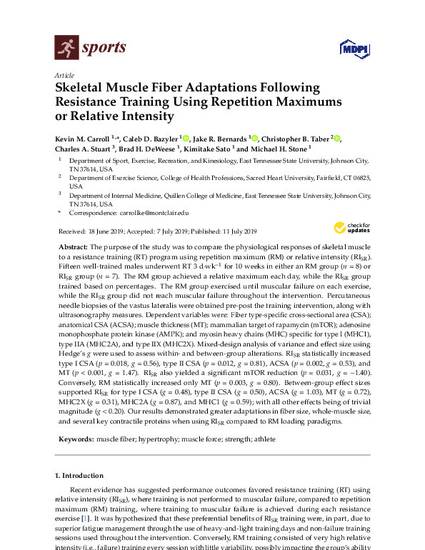
The purpose of the study was to compare the physiological responses of skeletal muscle to a resistance training (RT) program using repetition maximum (RM) or relative intensity (RISR). Fifteen well-trained males underwent RT 3 d·wk−1 for 10 weeks in either an RM group (n = 8) or RISR group (n = 7). The RM group achieved a relative maximum each day, while the RISR group trained based on percentages. The RM group exercised until muscular failure on each exercise, while the RISR group did not reach muscular failure throughout the intervention. Percutaneous needle biopsies of the vastus lateralis were obtained pre-post the training intervention, along with ultrasonography measures. Dependent variables were: Fiber type-specific cross-sectional area (CSA); anatomical CSA (ACSA); muscle thickness (MT); mammalian target of rapamycin (mTOR); adenosine monophosphate protein kinase (AMPK); and myosin heavy chains (MHC) specific for type I (MHC1), type IIA (MHC2A), and type IIX (MHC2X). Mixed-design analysis of variance and effect size using Hedge’s g were used to assess within- and between-group alterations. RISR statistically increased type I CSA (p = 0.018, g = 0.56), type II CSA (p = 0.012, g = 0.81), ACSA (p = 0.002, g = 0.53), and MT (p < 0.001, g = 1.47). RISR also yielded a significant mTOR reduction (p = 0.031, g = −1.40). Conversely, RM statistically increased only MT (p = 0.003, g = 0.80). Between-group effect sizes supported RISR for type I CSA (g = 0.48), type II CSA (g = 0.50), ACSA (g = 1.03), MT (g = 0.72), MHC2X (g = 0.31), MHC2A (g = 0.87), and MHC1 (g = 0.59); with all other effects being of trivial magnitude (g < 0.20). Our results demonstrated greater adaptations in fiber size, whole-muscle size, and several key contractile proteins when using RISR compared to RM loading paradigms
Carroll, K. M., Bazyler, C. D., Bernards, J. R., Taber, C. B., Stuart, C. A., DeWeese, B. H., Sato, K., & Stone, M. H. (2019). Skeletal muscle fiber adaptations following resistance training using repetition maximums or relative intensity. Sports, 7(7), 169. Doi: doi.org/10.3390/sports7070169

Open access, Creative Commons Attribution License